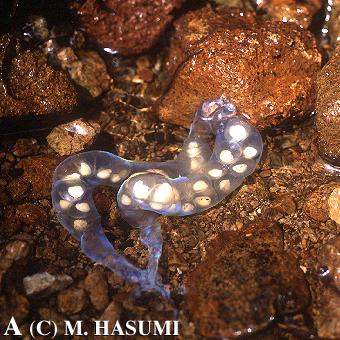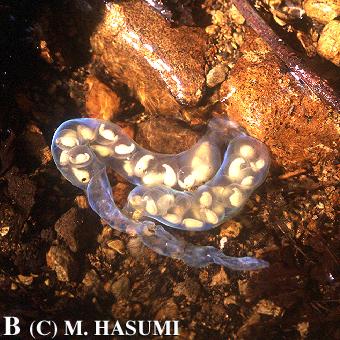

 |  |
(A) A pair of egg sacs, including 17 embryos (3 of them were crushed) and 18 embryos (5 of them were unfertilized) of the early tail-bud stage (photographed on 30 April 2005). The egg sacs, the adhesive tips of which were attached to a small stone of 69.0 x 50.4 mm, were discovered after the removal of several small stones and decaying leaves accumulated in a plain approximately 3 m from below a 1.3 m cascade of the torrent (water temperature = 6.0 C, water pHs = 6.7-6.8; for comparison, snow pH = 5.3). Deposition of the egg sacs was estimated to occur more than 1 month ago.
At the time of examination, 1 overwintering larva was found in the torrent; 1 male and 1 small juvenile, respectively, under decaying logs above ground on land approximately 20 cm and 40 cm from the side of the torrent. The juvenile was estimated to metamorphose in late of the last fall because it did not have much yellow coloration of the skin, which is characteristic of larvae of H. kimurae. One of egg sacs (composed of 20 unfertilized eggs) and one of egg sacs (only 2 unfertilized eggs) were collected separately among decaying leaves accumulated below the cascade (carried away?). It was unknown whether or not the two egg sacs were a pair.
(B) Development of the embryos in the torrent (water temperature = 9.8 C, water pH = 6.5) after a couple of weeks (photographed on 14 May 2005). The embryos were at the elongated tail-bud stage. Note a beautiful, fluorescent color of the egg sacs, as shown in another population.
Accompanied Research Collaborators (alphabetical order): Masaichi Kakegawa (Tokyo Metropolitan Komatsugawa Senior High School), and Fujio Kishi and Yuko Saikawa (Shirouma Association of Naturalists).